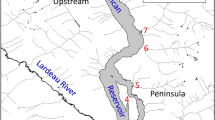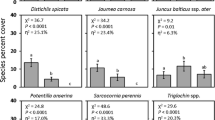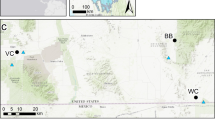Abstract
The purpose of this research was to determine if slope and exposure are important determinants of plant communities emerging on reservoir shorelines. We sampled 30 sites on the previously inundated shoreline of Cave Run Lake, a U.S. Army Corps of Engineers flood-control reservoir in east-central Kentucky, USA. These sites were categorized as either flats, riparian forests, exposed banks, or sheltered banks Two-way indicator species analysis (TWINSPAN) and detrended correspondence analysis were used with presence/absence data to group sites of similar community composition. These were 167 species of plants identified in the study plots, of which 29% were annuals, 2% were biennials, 69% were perennials, 11% were non-indigenous, and 63% met the criterion for inclusion in community analysis. A distinct assemblage of plant species was associated with all riparian forests, with six of eight flats, and with five of twelve exposed banks. Six sheltered banks were not obviously associated with a single community type. The TWINSPAN group including riparian forests had the highest percentage of wetland species; the TWINSPAN group including most flats had the highest species richness; the TWINSPAN group comprised entirely of exposed banks had low species richness and low representation of wetland species. Our results suggest that plant communities of high conservation value can emerge on relatively flat sites under a human-controlled flooding regimen as long as the soil remains intact. However, steep exposed banks are susceptible to soil loss, and the resulting rock substrates support a depauperate flora of low conservation value.
Similar content being viewed by others
Literature Cited
Avers, P. E., J. S. Austin, J. K. Long, P. M. Love, and C. W. Hail 1974. Soil survey of Menifee and Rowan counties and north-western Morgan country, Kentucky. U.S. Department of Agriculture Forest Service and Soil Conservation Service. Washington DC, USA.
Bernard, C., F. Mouilot, and H. P. Christophe. 1998. Flood drift and propagule bank of aquatic macrophytes in a riverine wetland. Journal of Vegetation Science 9:631–640.
Dittmar, L. A. and R. K. Neely. 1999. Wetland seed bank response to sedimentation varying in loading rate and texture. Wetlands 19: 341–351.
Gleason, H. A. and A. Cronquist. 1991. Manual of the Vascular Plants of Northeastern United States and Adjacent Canada, 2nd edition. New York Botanical Garden, Bronx, NY, USA.
Hall, T. F. and G. E. Smith. 1955 Effects of flooding on woody plants, West Sandy Dewatering Project, Kentucky Reservoir. Journal of Forestry 53:281–285.
Hill, M. H, P. A. Keddy, and I. C. Wisheu. 1998. A hydrological model for predicting the effects of dams on the shoreline vegetation of lakes and reservoirs. Environmental Management 5:723–736.
Hill, M. O. and H. G. Gauch. 1980. Detrended correspondence analysis: an improved ordination technique. Vegetatio 42: 47–58.
Hill, M. O., R. G. H. Bunce, and M. W. Shaw. 1975. Indicator species analysis, a divisive polythetic method of classification, and it application to a survey of native pinewoods in Scotland. Journal of Ecology 63:597–613.
Hoagland, B. W. and R. L. Jones. 1992. Wetland and riparian flora of the Upper Green River Basin, south-central Kentucky. Transactions of the Kentucky Academy of Science 53:141–153.
Keddy, P. A.. 1983. Shoreline vegetation in Axe Lake, Ontario: effects of exposure on zonation patterns. Ecology 64:331–344.
Keddy, P. A. 1985. Wave disturbance on lakeshores and the within-lake distribution of Ontario’s Atlantic coastal plain flora. Canadian Journal of Botany 63:656–660.
Keddy, P. A. and A. A. Reznicek. 1986. Great Lakes vegetation dynamics: the role of fluctuating water levels and buried seeds. Journal of Great Lakes Research 12:25–36.
Luken, J. O. and T. N. Bezold. 2000. Species richness and wetland status of different shoreline elements at Cave Run Lake, Kentuckly. Castanea 65:126–138.
Naiman, R. J., H. Decamps, and M. Pollock. 1993. The role of riparian corridors in maintaining regional biodiversity. Ecological Applications 3:209–212.
Nilsson, C. 1981. Dynamics of the shore vegetation of a North Swedish hydro-electric reservoir during a 5-year period. Acta Phytogeographica Suecica 69:1–94.
Nilsson, C. and P. A. Keddy. 1988. Predictability of change in shoreline vegetation along a hydroelectric reservoir, northern Sweden. Canadian Journal of Fisheries and Aquatic Sciences 45:1896–1904.
Nilsson, C., A. Ekblad, M. Gardfjell, and B. Carlberg. 1991. Long-term effects of river regulation on river margin vegetation. Journal of Applied Ecology 28:963–987.
Pickett, S. T. A., S. L. Collins, and J. J. Armesto. 1987. Models, mechanisms, and pathways of succession. The Botanical Review 53:335–371.
Planty-Tabacchi, A. M., E. Tabacchi, R. J. Naiman, C. Deferrari, and H. Decamps, 1996. Invasibility of species-rich communities in riparian zones. Conservation Biology 10:598–607.
Pollock, M. M. 1998. Biodiversity. p. 430–452. In R. J. Naiman and R. E. Bilby (eds.) River Ecology and Management. Springer-Verlag, New York, NY, USA.
Pollock, M. M., R. J. Naiman, and T. A. Hanley. 1998. Plant species richness in riparian wetlands — a test of biodiversity theory. Ecology 79:94–105.
Pysek, P. and K. Prach. 1993. Plant invasions and the role of riparian habitats: a comparison of four species alien to central Europe Journal of Biogeography 20:413–420.
Schneider, R. 1994. The role of hydrologic regime in maintaining rare plant communities of New York’s coastal plain pondshores. Biological Conservation 68:253–260.
Soballe, D. M., B. L. Kimmel, R. H. Kennedy, and R. F. Gaugush, 1992. Reservoirs. p. 421–474. In C. T. Hackney, S. M. Adams, and W. H. Martin (eds.), Biodiversity of the Southeastern United States. John Wiley and Sons, New York, NY, USA.
Tausch, R. J., D. A. Charlet, D. A. Weixelman, and D. C. Zamudio. 1995. Patterns of ordination and classification instability resulting from changes in input data order. Journal of Vegetation Science 6:897–902.
Trebino, H. J., E. J. Chaneton, and R. J. C. Leon. 1996. Flooding, topography, and successional age as determinants of species diversity in old-field vegetation. Canadian Journal of Botany 74: 582–588.
(USFWS) U.S. Fish And Wildlife Service. 1997. National list of vascular plant species that occur in wetlands: 1996 national summary. National Wetlands Inventory, U.S. Fish and Wildlife Service, Washington, DC, USA.
Zampella, R. A. and K. J. Laidig. 1997. Effect of watershed disturbance on Pinelands stream vegetation. The Journal of the Torrey Botanical Society 124:52–66.
Author information
Authors and Affiliations
Corresponding author
Rights and permissions
About this article
Cite this article
Luken, J.O., Bezold, T.N. Plant communities associated with different shoreline elements at Cave Run Lake, Kentucky. Wetlands 20, 479–486 (2000). https://doi.org/10.1672/0277-5212(2000)020<0479:PCAWDS>2.0.CO;2
Received:
Revised:
Accepted:
Published:
Issue Date:
DOI: https://doi.org/10.1672/0277-5212(2000)020<0479:PCAWDS>2.0.CO;2




